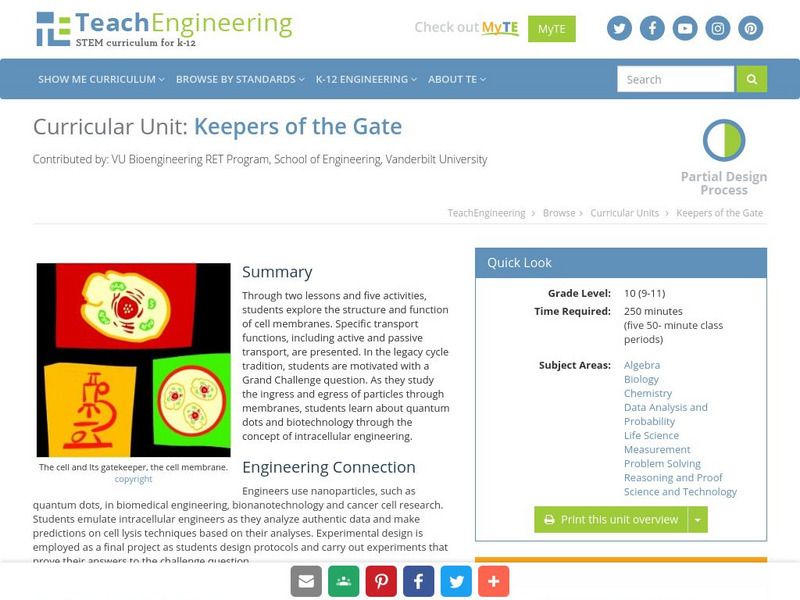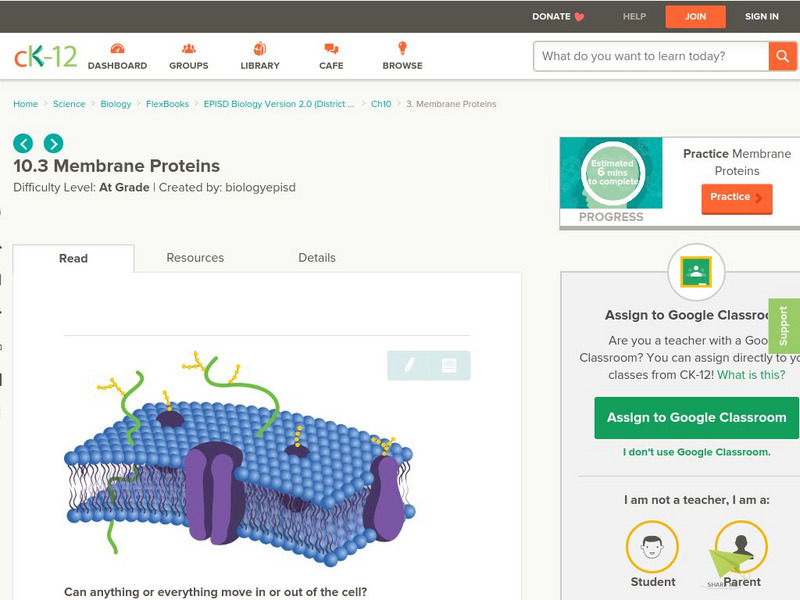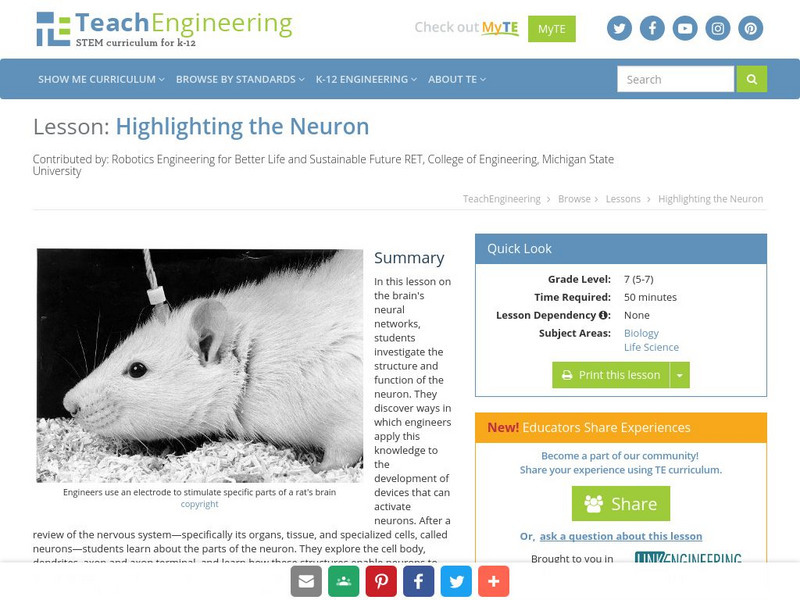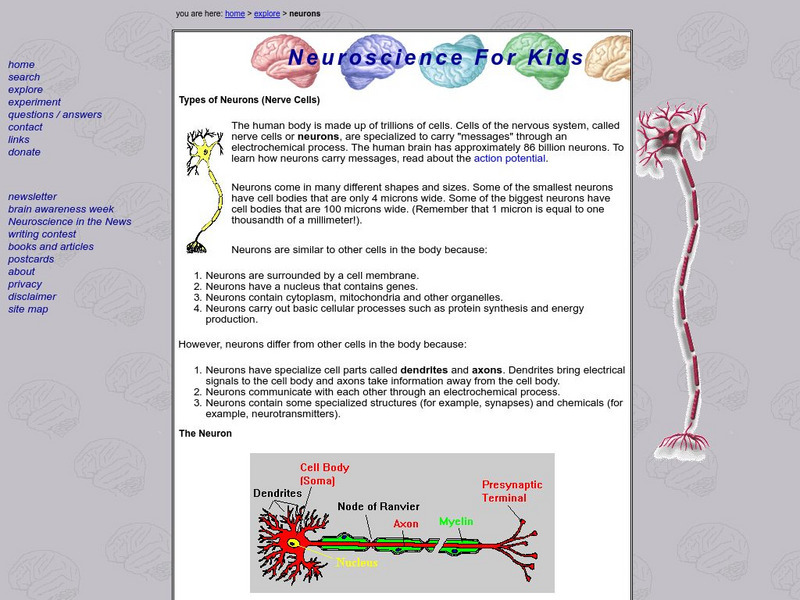Hi, what do you want to do?
CK-12 Foundation
Ck 12: Episd: Organization of the Human Body
[Free Registration/Login may be required to access all resource tools.] From basic cells to tissue to organ systems, identify and understand the structures and functions of the human body's organization.
TED Talks
Ted: Ted Ed: What Does the Liver Do?
There's a factory inside you that weighs about 1.4 kilograms and runs for 24 hours a day. It's your liver: the heaviest organ in your body, which simultaneously acts as a storehouse, a manufacturing hub, and a processing plant. This...
CK-12 Foundation
Ck 12: Phospholipid Bilayers
[Free Registration/Login may be required to access all resource tools.] Tutorial describes the detailed structure and function of the plasma membrane, explains semipermeability, and summarizes the structure of a phospholipid.
TeachEngineering
Teach Engineering: Keepers of the Gate
Through two lessons and five activities, students explore the structure and function of cell membranes. Specific transport functions, including active and passive transport, are presented. In the legacy cycle tradition, students are...
National Cancer Institute at the National Institutes of Health
Seer Training Modules: Introduction to the Lymphatic System
Self-guided learning activity where students learn about the structure and function of the human lymphatic system. There is a short quiz at the end of the lesson to check for understanding.
CK-12 Foundation
Ck 12: Membrane Proteins
[Free Registration/Login may be required to access all resource tools.] Activity explores proteins in the plasma membrane describing their structure and function. The Fluid Mosaic Model is also summarized.
TeachEngineering
Teach Engineering: Highlighting the Neuron
In this instructional activity on the brain's neural networks, young scholars investigate the structure and function of the neuron. They discover ways in which engineers apply this knowledge to the development of devices that can...
TED Talks
Ted: Ted Ed: How We See Color
There are three types of color receptors in your eye: red, green and blue. But how do we see the amazing kaleidoscope of other colors that make up our world? The following learning module explains how humans can see everything from...
National Cancer Institute at the National Institutes of Health
Seer Training Modules: Introduction to the Nervous System
Self-guided learning activity where students learn about the structure and function of the human nervous system. There is a short quiz at the end of the lesson to check for understanding.
Georgia Department of Education
Ga Virtual Learning: Ap Biology: Animals
This unit focuses on the unique structure and function of both invertebrate and vertebrate animals. Students review their understanding of animal diversity, and take a closer look at the various organ systems found in the animal kingdom.
National Cancer Institute at the National Institutes of Health
Seer Training Modules: Introduction to the Reproductive System
Self-guided learning activity where students learn about the structure and function of the male and female reproductive systems. There is a short quiz at the end of the lesson to check for understanding.
CK-12 Foundation
Ck 12: Life Science: 11.41 Nerve Impulse
Understand the structure and function of a nerve cell, and how messages are transmitted throughout the human body.
University of Washington
University of Washington: Types of Neurons
A good straightforward presentation of the different forms of neurons based on function. Includes easy to read graphics on the subject.
Georgia Department of Education
Ga Virtual Learning: Biology: The Study of Life
A learning module where students analyze the relationships between the structures and functions of cells, tissues, organs to carry out all of the requisite characteristics of life. They also describe the scope of biological study and...
BiologyWise
Biology Wise: What Is the Nucleolus?
The characteristics, structure, and functions of the nucleolus are described.
Sophia Learning
Sophia: Endoplasmic Reticulum: Lesson 4
This lesson will discuss the structure and function of both rough and smooth endoplasmic reticulum. It is 4 of 6 in the series titled "Endoplasmic Reticulum."
Sophia Learning
Sophia: Ear Anatomy and Hearing
This lesson will give an overview of the anatomy of the human ear.
Other
Net Wellness: Skin Care
Contains information about the following: how the skin functions, skin structure, the epidermis, the stratum corneum, the middle epidermis, the basal layer, epidermal cell summary, the dermis, aging and its effects on the skin, natural...
Curated OER
Micscape Article: Paramecium
Excellent article on a unicelluar organism, the paramecium. Includes details on its environment, paramecium types, and environmental importance.
Curated OER
Micscape Article: Paramecium
Excellent article on a unicelluar organism, the paramecium. Includes details on its environment, paramecium types, and environmental importance.
Curated OER
Hanover College: Neural Structure Quiz
Excellent site to review what you know. You're given a labeled diagram of a neuron and you must identify the parts. Good Luck!
Curated OER
The World of Cells: Golgi Apparatus
A very brief explanation of the structure and function of this organelle.
Curated OER
The Virtual Cell: Cell Biology
In this interactive site, you are presented with a picture of a cell and a description of the structure and function of the parts of the cell. Pictures are colorful and the explanations are short but informative.
Hanover College
Hanover College: The Physical Factors Behind the Action
A frames page that gives the background to understand the way cells communicate (nerve cells). Each topic in the left frame triggers a tutorial on the right. Most have graphics or animated gifs to teach the material. Good background to...


















